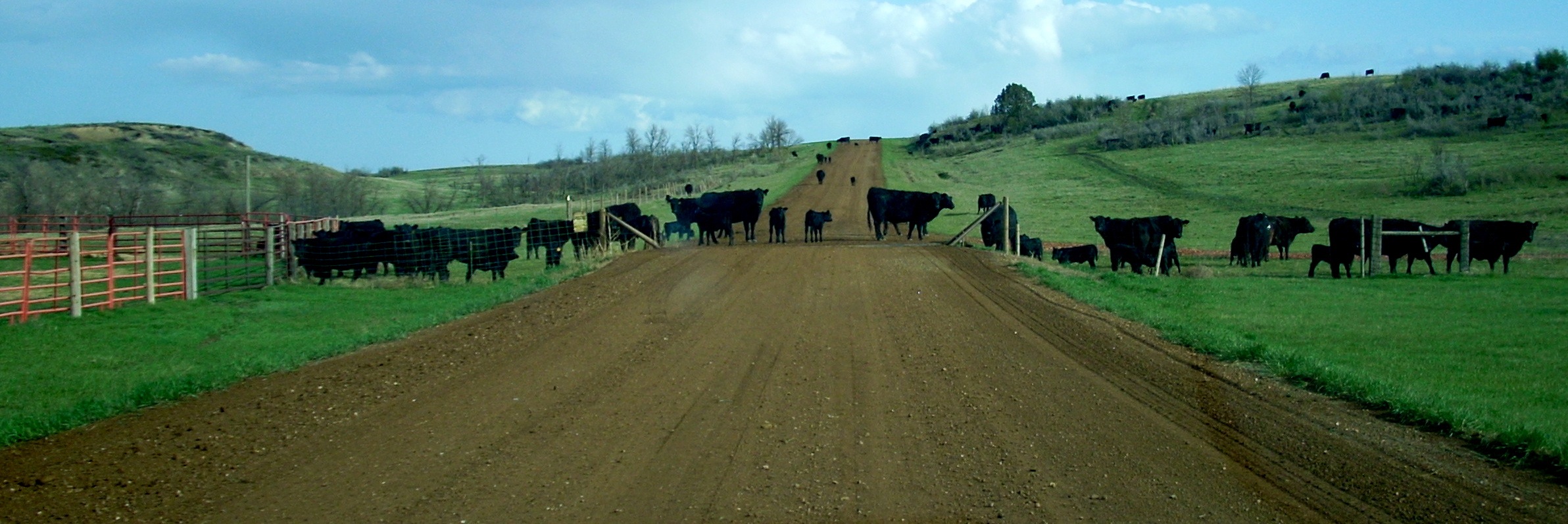
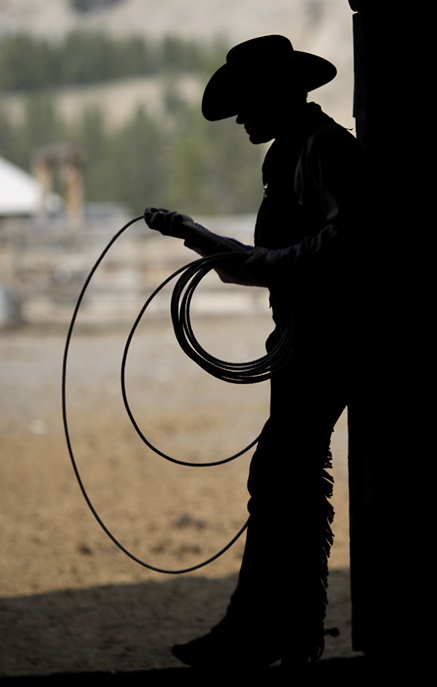
| Route 66 | Cities | Beaches |
 |
 |
Knife River Indian Village |
Fort Benton |
Enchanted Highway |
The drive to Elkhorn Ranch is a beautiful afternoon on America's "Inland Sea," as Roosevelt himself described it. You'll be on dirt and clay roads 45 miles off the interstate, crossing Little Missouri Grasslands and some private land. This is the heart of the Cattle Empire, and you'll see plenty of them. But it's also the heart of the huge Dakota oil fields, and you'll see plenty of derricks pumping black gold. You may also see antelope, mule deer, buffalo, grouse and other wildlife. What you won't see are trees. Before leaving Medora, stop by the Visitor Center and check for news on the latest road conditions. If it has rained within the last 24 hours, do not make the trip. You'll be on bentonite clay roads which when wet become quicksand. You'll find yourself hopelessly stuck and have to hike to the nearest ranch for a tow. The next passing vehicle could be hours away. So wait for a dry sunny day. If you're staying at the Buffalo Gap Ranch you could just come out to the interstate and turn right (West), if you've already checked with the Visitor Center. But you need their map. |
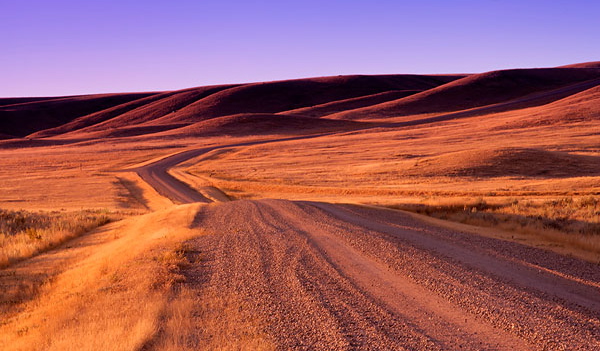 |
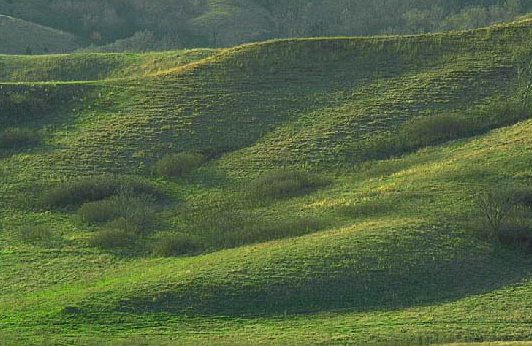 |
Heading West on I-94, turn right (North) on County Road 11. The Park Service map is their own drawing superimposed on a Forest Service map of the Little Missouri National Grassland. This beautiful land was once destroyed by homesteaders who did not understand the High Plains. They tried to farm this soil like they had back East or in Europe. They plowed the soil and planted crops. You can't do that here. The soil is too shallow and has a thin crust to protect it from high wind and drought. So once plowed, nothing would grow, the soil began blowing away, and the precious grass cover was gone. The homesteaders went bankrupt and returned to the East. The government bought back their land at pennies per acre, created the National Grassland, patiently restored grass cover (it took two decades), and now lease large sections to adjacent ranchers for their cattle. This is cattle country, not tomato or corn country. Range management specialists adjust cattle quotas to match seasons of drought or rain. Following a drought year, they will cut back on the size of herd a rancher can graze on his leased acres. Once the grass recovers, they'll increase the quotas. This causes frequent arguments, but it works. |
| You'll come due North on 11 for six miles, zig right (East) for a mile, then zag North for another three miles. Watch carefully. Westerheim Road will turn right off Route 11. There's actually a street sign way out here. Then you drive East a mile, zig North, zag East, North and East again. At this point you have to really pay attention. Half of all the people who come out here drive through this turn. You'll come to a four way cross where going straight ahead will take you down a long hill. Do not go straight ahead. Turn left onto Bell Lake Road, which is also Forest Service Road 708. This is somewhat of a local joke. Nobody has ever seen Bell Lake. Usually, there's not enough water out here for a puddle, let alone a lake. But head North on Bell Lake Road anyway, and stay on it for about 12 miles. At the l2 mile mark on your odometer, look for a right turn down a long hill on Forest Service Road FH2, also marked by a sign reading "FS Elkhorn Camp." This takes you first to the Elkhorn Campground, then on around the bend to the Elkhorn Ranch Trailhead. It's about a mile hike back into the ranch site. | 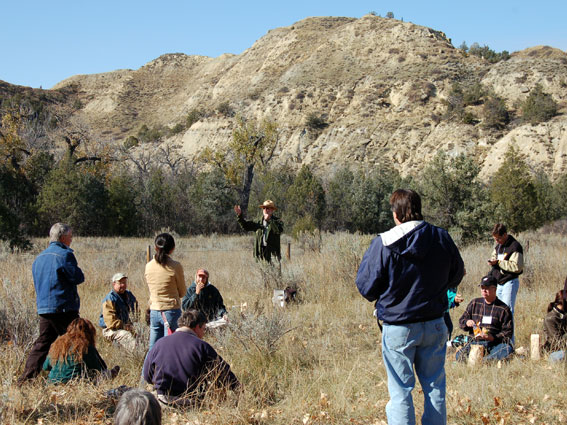 |
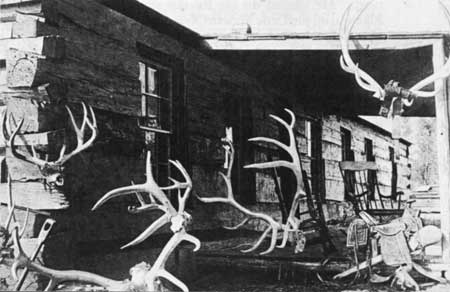 |
Today there are no buildings left at the ranch site. Once Roosevelt sold the ranch the buildings were dismantled and the materials and furnishings used to build other ranchhouses in the area. This was a shame because the ranchhouse was the finest in North Dakota. The photo at left was taken by TR himself, and below right is a sketch showing how the ranchhouse and other buildings looked when he was here. Today there are descriptive placques, and markers and foundations are still in place so you can locate where the buildings were. You can imagine Roosevelt sitting on the porch looking out over the river or across at the badlands and working on one of his books. It's interesting to compare this location with Thoreau's Walden Pond cabin and think about the impact the two men had on American culture. Thoreau focused America's thinking on Nature and Roosevelt refocused it on Conservation. We study TR's achievements as New York Police Commissioner, military leader and president, but had he remained a Dakota rancher we would study him as we do Thoreau, as a writer and philosopher. |
| Roosevelt's impact here was a series of ironies. He first came to North Dakota to kill Buffalo, and did kill one, but became the man who saved the Buffalo from extinction. He grew up sickly and became a national symbol of the cowboy and outdoorsman. He left North Dakota for a career in New York and Washington, but gave America and the world the idea of a strong national park system so everyone could enjoy their natural heritage. He claimed to be "roughing it," but his ranchhouse here contained every amenity available in the 1880s. |  |
|
|||
|